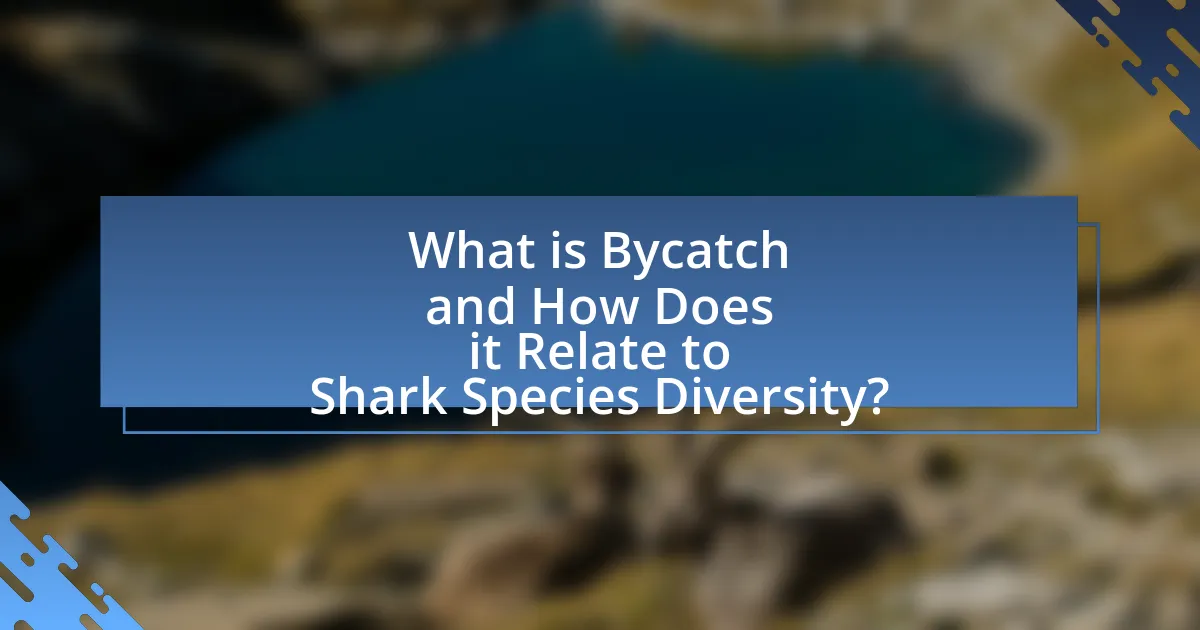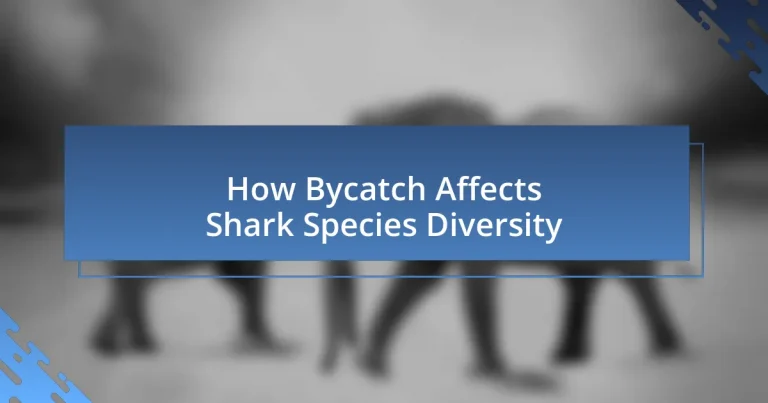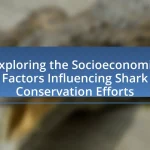Bycatch refers to the unintentional capture of non-target species during fishing activities, which poses a significant threat to shark species diversity. This article examines the impact of bycatch on shark populations, highlighting how it leads to population declines, reduced genetic diversity, and disruptions in marine ecosystems. It discusses the types of species commonly caught as bycatch, the ecological and economic implications of these practices, and the specific threats faced by different shark species. Additionally, the article explores potential solutions to mitigate bycatch, including the use of selective fishing gear, regulations, and conservation efforts aimed at protecting shark diversity and promoting sustainable fishing practices.

What is Bycatch and How Does it Relate to Shark Species Diversity?
Bycatch refers to the unintentional capture of non-target species during fishing activities, which significantly impacts shark species diversity. This unintended catch often includes various shark species that are not the primary target of fishing operations, leading to population declines and disruptions in marine ecosystems. For instance, studies indicate that bycatch can account for up to 40% of total catch in some fisheries, resulting in substantial mortality rates for vulnerable shark populations. The loss of these species can reduce genetic diversity and alter community structures within marine environments, ultimately threatening the resilience of shark populations and their ecological roles.
How is Bycatch Defined in the Context of Fisheries?
Bycatch in the context of fisheries is defined as the unintentional capture of non-target species during fishing activities. This includes various marine organisms such as fish, mammals, birds, and invertebrates that are caught while targeting specific species. According to the Food and Agriculture Organization (FAO), bycatch can account for up to 40% of the total catch in some fisheries, leading to significant ecological impacts and threatening the sustainability of marine biodiversity, including shark species diversity.
What Types of Species are Commonly Considered Bycatch?
Commonly considered bycatch species include non-target fish, marine mammals, sea turtles, and seabirds. These species are often unintentionally caught during fishing operations targeting specific fish populations. For instance, studies have shown that in commercial fisheries, species such as juvenile fish, dolphins, and various species of turtles frequently end up as bycatch, leading to significant ecological impacts. According to the Food and Agriculture Organization, bycatch can account for up to 40% of total catch in some fisheries, highlighting the scale of the issue and its implications for marine biodiversity, including shark species diversity.
How Does Bycatch Impact Marine Ecosystems?
Bycatch significantly impacts marine ecosystems by disrupting the balance of species populations and harming biodiversity. When non-target species, including sharks, are unintentionally caught in fishing gear, their mortality can lead to declines in their populations, which in turn affects the entire food web. For instance, studies have shown that the decline of apex predators like sharks can result in an overabundance of their prey, leading to imbalances that affect the health of coral reefs and other marine habitats. This disruption can diminish ecosystem resilience, making it harder for marine environments to recover from other stressors such as climate change and pollution.
Why is Shark Species Diversity Important?
Shark species diversity is important because it contributes to the overall health and stability of marine ecosystems. Diverse shark populations help regulate prey species, maintain the balance of marine food webs, and support biodiversity. For instance, studies have shown that areas with higher shark diversity experience greater resilience to environmental changes, as different species fulfill various ecological roles. This diversity also enhances the ability of ecosystems to recover from disturbances, such as overfishing or habitat loss, thereby ensuring the sustainability of marine resources.
What Role Do Sharks Play in Marine Ecosystems?
Sharks play a crucial role in marine ecosystems as apex predators, helping to maintain the balance of marine life. By regulating the populations of prey species, sharks prevent overgrazing of vital habitats such as seagrass beds and coral reefs, which are essential for biodiversity. Research indicates that the removal of sharks can lead to an increase in smaller predator populations, resulting in a decline in herbivorous species and subsequent degradation of marine ecosystems. For example, studies have shown that in areas where shark populations have declined, there has been a noticeable increase in the number of rays, which in turn negatively impacts the populations of shellfish and other marine organisms. This illustrates the interconnectedness of species within marine environments and highlights the importance of sharks in sustaining healthy ecosystems.
How Does Shark Diversity Contribute to Ocean Health?
Shark diversity contributes to ocean health by maintaining the balance of marine ecosystems. Different shark species occupy various ecological niches, which helps regulate prey populations and promotes biodiversity. For instance, apex predators like great white sharks control the populations of marine mammals and fish, preventing overgrazing of seagrass and coral reefs. This regulation supports the overall health of marine habitats, as evidenced by studies showing that areas with diverse shark populations exhibit greater resilience and stability in their ecosystems.
What Are the Main Causes of Bycatch in Shark Populations?
The main causes of bycatch in shark populations include the use of non-selective fishing gear, such as gillnets and longlines, which inadvertently capture sharks along with target species. These fishing methods often lack mechanisms to prevent the capture of non-target species, leading to significant shark mortality. According to a study published in the journal “Marine Policy,” it is estimated that millions of sharks are caught as bycatch annually, contributing to declines in their populations and threatening species diversity. Additionally, the increasing demand for seafood and the expansion of fishing activities into shark habitats exacerbate the issue, further increasing the likelihood of bycatch incidents.
How Do Fishing Methods Contribute to Bycatch Rates?
Fishing methods significantly contribute to bycatch rates by employing techniques that unintentionally capture non-target species. For instance, trawling and gillnetting are known to have high bycatch rates due to their indiscriminate nature, often resulting in the capture of sharks, rays, and other marine life alongside the intended catch. Studies indicate that trawl fisheries can have bycatch rates exceeding 50% of the total catch weight, highlighting the inefficiency and ecological impact of these methods. Additionally, the use of longlines can also lead to substantial bycatch, as they can hook various species, including vulnerable shark populations, which may not survive the capture. This evidence underscores the direct correlation between specific fishing methods and increased bycatch rates, ultimately affecting shark species diversity and marine ecosystems.
What Are the Specific Threats to Different Shark Species?
Different shark species face specific threats primarily from overfishing, habitat loss, and climate change. For instance, the hammerhead shark is particularly threatened by targeted fishing for its fins, leading to significant population declines. The great white shark encounters threats from bycatch in commercial fisheries, which can result in unintentional capture and mortality. Additionally, the whale shark, the largest shark species, suffers from habitat degradation due to coastal development and pollution, impacting its feeding grounds. According to the International Union for Conservation of Nature (IUCN), many shark species are classified as vulnerable or endangered, highlighting the urgent need for conservation efforts to address these threats.

How Does Bycatch Affect Shark Species Diversity Specifically?
Bycatch significantly reduces shark species diversity by unintentionally capturing and killing non-target shark species during fishing operations. This unintentional catch leads to population declines in various shark species, disrupting their ecological roles and diminishing genetic diversity. For instance, studies have shown that bycatch can account for up to 40% of total shark mortality in certain fisheries, which directly impacts species richness and abundance. The loss of individual sharks from diverse species can lead to altered predator-prey dynamics and affect the overall health of marine ecosystems.
What Are the Direct Effects of Bycatch on Shark Populations?
Bycatch directly reduces shark populations by causing unintentional capture and mortality of non-target species during fishing activities. This unintended catch can lead to significant declines in shark numbers, particularly for vulnerable species that are already facing threats from overfishing and habitat loss. Studies indicate that bycatch can account for up to 30% of total shark mortality in certain fisheries, exacerbating the decline of already endangered species. For example, the International Union for Conservation of Nature (IUCN) reports that many shark species are classified as threatened or near threatened, largely due to fishing pressures, including bycatch.
How Does Bycatch Lead to Population Declines in Sharks?
Bycatch leads to population declines in sharks primarily through unintentional capture during fishing activities, which results in significant mortality rates. When sharks are caught as bycatch, they often suffer injuries or stress that can lead to death, either immediately or post-release. Studies indicate that bycatch can account for up to 40% of total shark mortality in certain fisheries, severely impacting their populations. For instance, the International Union for Conservation of Nature (IUCN) reports that many shark species are experiencing declines due to high bycatch rates, contributing to their vulnerability and risk of extinction.
What Are the Long-Term Consequences of Reduced Shark Diversity?
Reduced shark diversity leads to significant long-term ecological consequences, including disrupted marine ecosystems and diminished resilience to environmental changes. Sharks play a crucial role as apex predators, maintaining the balance of marine food webs. A decline in their diversity can result in overpopulation of prey species, which may lead to habitat degradation and altered community structures. For instance, studies have shown that the loss of large shark species can cause a cascade effect, resulting in increased numbers of smaller predatory fish, which in turn can deplete herbivorous fish populations, ultimately affecting coral reef health. This ecological imbalance can reduce biodiversity and the overall health of marine environments, making them more vulnerable to stressors such as climate change and pollution.
How Does Bycatch Impact the Genetic Diversity of Shark Species?
Bycatch significantly reduces the genetic diversity of shark species by removing individuals from populations, particularly those that are less abundant or genetically distinct. This reduction in population size can lead to inbreeding, which decreases genetic variation and the ability of populations to adapt to environmental changes. Studies have shown that overfishing and bycatch can lead to the loss of unique genetic lineages, as evidenced by the decline of specific shark populations in various regions, such as the decline of the hammerhead shark populations in the Atlantic due to high bycatch rates. This loss of genetic diversity ultimately threatens the resilience and survival of shark species in the long term.
What Is the Importance of Genetic Diversity in Sharks?
Genetic diversity in sharks is crucial for their survival and adaptability. It enhances their ability to cope with environmental changes, diseases, and human impacts, thereby ensuring the resilience of shark populations. For instance, studies have shown that populations with higher genetic diversity are more likely to survive and reproduce successfully in changing habitats, as they possess a wider range of traits that can be beneficial under different conditions. This adaptability is vital, especially in the face of threats such as overfishing and habitat loss, which can significantly reduce genetic variation. Therefore, maintaining genetic diversity is essential for the long-term health and sustainability of shark species.
How Can Bycatch Reduce Genetic Variation Among Shark Populations?
Bycatch can reduce genetic variation among shark populations by disproportionately removing specific individuals from the gene pool, particularly those of certain sizes, ages, or genetic traits. This selective removal can lead to a decrease in genetic diversity, as fewer individuals contribute to reproduction. For instance, studies have shown that when larger, more genetically diverse sharks are caught as bycatch, the remaining population may become more homogenous, limiting the genetic variability necessary for adaptation to environmental changes. This reduction in genetic variation can ultimately threaten the resilience and survival of shark populations.
What Are the Economic Implications of Bycatch on Shark Species Diversity?
Bycatch significantly impacts shark species diversity, leading to economic implications such as reduced fishery yields and increased management costs. The unintentional capture of sharks in commercial fishing operations diminishes their populations, which can disrupt marine ecosystems and affect the sustainability of fisheries. For instance, studies indicate that bycatch can lead to a decline in shark populations by up to 90% in certain regions, resulting in fewer sharks available for both ecological balance and commercial exploitation. This decline can ultimately lead to lower catches of commercially valuable fish species that rely on sharks for ecosystem health, thereby affecting the livelihoods of fishermen and the economic viability of fisheries.
How Does Bycatch Affect Fisheries Economically?
Bycatch negatively impacts fisheries economically by reducing the overall catch and increasing operational costs. When non-target species are unintentionally caught, they often require additional handling, which can lead to increased labor and processing expenses. According to a study published in the journal “Fish and Fisheries,” bycatch can account for up to 40% of total catch in some fisheries, leading to significant economic losses for fishers who rely on specific target species for their livelihoods. Furthermore, the depletion of target species due to bycatch can result in long-term economic instability for fisheries, as overfishing can diminish stock levels and reduce future catch potential.
What Are the Costs of Losing Shark Species to Bycatch?
The costs of losing shark species to bycatch include significant ecological and economic impacts. Ecologically, sharks play a crucial role in marine ecosystems as apex predators, helping to maintain the balance of species populations. Their decline can lead to overpopulation of prey species, resulting in ecosystem imbalances. Economically, the loss of shark species affects fisheries and tourism industries; for instance, the global shark-related tourism industry is valued at approximately $314 million annually, highlighting the financial implications of declining shark populations due to bycatch.

What Solutions Exist to Mitigate Bycatch and Protect Shark Diversity?
Solutions to mitigate bycatch and protect shark diversity include the implementation of bycatch reduction devices, the use of selective fishing gear, and the establishment of marine protected areas. Bycatch reduction devices, such as turtle excluder devices and fish traps with escape openings, allow non-target species to escape while retaining target species. Selective fishing gear, like circle hooks and bait types that attract specific species, minimizes the capture of sharks and other non-target species. Additionally, marine protected areas restrict fishing activities in critical habitats, allowing shark populations to recover and thrive. Research indicates that these strategies can significantly reduce bycatch rates and enhance the conservation of shark diversity, as evidenced by studies showing improved population dynamics in protected regions.
What Strategies Can Be Implemented to Reduce Bycatch?
To reduce bycatch, implementing strategies such as the use of selective fishing gear, time-area closures, and bycatch reduction devices is essential. Selective fishing gear, like circle hooks and modified nets, minimizes the capture of non-target species, thereby decreasing bycatch rates. Time-area closures restrict fishing activities in specific locations during critical periods for vulnerable species, which helps protect them from being unintentionally caught. Bycatch reduction devices, such as escape panels in nets, allow non-target species to escape while retaining the target catch. These strategies have been supported by studies indicating that their application can significantly lower bycatch rates, thus contributing to the conservation of shark species and enhancing biodiversity.
How Can Fishing Gear Innovations Help Minimize Bycatch?
Fishing gear innovations can significantly minimize bycatch by incorporating selective designs and technologies that target specific species while reducing the capture of non-target species. For instance, the use of circle hooks has been shown to decrease the bycatch of sea turtles and other non-target species compared to traditional J-hooks, as they are less likely to be swallowed deeply. Additionally, advancements such as modified nets with escape panels allow smaller or non-target fish to escape while retaining the target catch, effectively reducing bycatch rates. Research indicates that implementing these innovations can lead to a reduction in bycatch by up to 50%, thereby supporting the conservation of vulnerable species, including sharks, which are often affected by bycatch in commercial fishing operations.
What Role Do Regulations Play in Reducing Bycatch Rates?
Regulations play a crucial role in reducing bycatch rates by establishing legal frameworks that limit the capture of non-target species during fishing activities. These regulations often include measures such as gear restrictions, seasonal closures, and catch limits, which are designed to minimize the incidental capture of vulnerable species, including sharks. For instance, the implementation of the Magnuson-Stevens Fishery Conservation and Management Act in the United States has led to significant reductions in bycatch through the establishment of fishery management plans that prioritize sustainable practices. Studies indicate that fisheries adhering to strict regulations can reduce bycatch rates by up to 50%, thereby contributing to the conservation of shark species and enhancing their diversity in marine ecosystems.
How Can Conservation Efforts Support Shark Species Diversity?
Conservation efforts can support shark species diversity by implementing protective measures that reduce bycatch and habitat destruction. These efforts include establishing marine protected areas (MPAs), which have been shown to enhance biodiversity by providing safe breeding and feeding grounds for various shark species. For instance, a study published in the journal “Conservation Biology” found that MPAs can lead to a 50% increase in shark populations within their boundaries. Additionally, promoting sustainable fishing practices and enforcing regulations on fishing gear can significantly decrease the incidental capture of sharks, thereby preserving their populations and genetic diversity.
What Are Effective Conservation Programs for Sharks?
Effective conservation programs for sharks include the establishment of marine protected areas (MPAs), regulations on shark fishing, and public awareness campaigns. Marine protected areas help to create safe habitats where shark populations can thrive, as evidenced by studies showing increased shark abundance in MPAs compared to unprotected areas. Regulations on shark fishing, such as catch limits and bans on shark finning, are crucial for reducing overfishing and bycatch, which significantly impact shark species diversity. Public awareness campaigns educate communities about the ecological importance of sharks and promote sustainable practices, leading to increased support for conservation efforts. These combined strategies have been shown to enhance shark populations and biodiversity in various regions globally.
How Can Public Awareness Campaigns Help Reduce Bycatch?
Public awareness campaigns can significantly reduce bycatch by educating the public about its impacts on marine ecosystems, particularly on shark species diversity. These campaigns raise awareness of the consequences of bycatch, such as the decline in shark populations, which can disrupt marine food webs and biodiversity. For instance, a study published in the journal “Conservation Biology” found that increased public knowledge about bycatch led to greater support for sustainable fishing practices and regulations. By informing communities about the importance of sharks and the threats posed by bycatch, these campaigns can foster responsible consumer behavior and encourage advocacy for policy changes that protect vulnerable species.
What Can Individuals Do to Help Reduce Bycatch and Protect Sharks?
Individuals can help reduce bycatch and protect sharks by supporting sustainable seafood choices and advocating for responsible fishing practices. By choosing seafood certified by organizations like the Marine Stewardship Council, individuals contribute to fisheries that prioritize the reduction of bycatch. Additionally, individuals can engage in local conservation efforts, such as beach clean-ups and educational programs, which raise awareness about the impact of bycatch on shark populations. Research indicates that sustainable fishing practices can significantly decrease bycatch rates, thereby aiding in the preservation of shark species diversity.
How Can Consumers Make Informed Choices About Seafood?
Consumers can make informed choices about seafood by researching sustainable fishing practices and understanding the impact of bycatch on marine ecosystems. Sustainable seafood guides, such as those provided by organizations like the Marine Stewardship Council, offer information on which seafood options are environmentally friendly and which contribute to overfishing and bycatch. Bycatch, the unintended capture of non-target species, significantly affects shark populations, leading to declines in species diversity. Studies indicate that bycatch can account for up to 40% of total catch in some fisheries, highlighting the importance of choosing seafood from fisheries that minimize bycatch. Therefore, consumers should prioritize seafood labeled as sustainable and seek information on the fishing methods used to ensure their choices support marine biodiversity.
What Actions Can Recreational Fishers Take to Minimize Bycatch?
Recreational fishers can minimize bycatch by using selective fishing gear, adhering to local regulations, and practicing catch-and-release techniques. Selective fishing gear, such as circle hooks and barbless hooks, reduces the likelihood of unintentionally capturing non-target species. Adhering to local regulations ensures that fishers are aware of size and bag limits, which helps protect vulnerable species. Practicing catch-and-release techniques, especially for species that are not intended for consumption, allows fishers to return non-target species to their habitats, thereby reducing mortality rates. Studies indicate that these practices can significantly decrease bycatch rates, contributing to the conservation of shark species and overall marine biodiversity.

